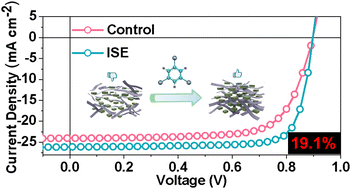Film-formation dynamics coordinated by intermediate state engineering enables efficient thickness-insensitive organic solar cells†
Abstract
The severe carrier recombination and enormous trap density induced by the anisotropic aggregation state and ungovernable scale of phase separation not only constrain the photovoltaic performance, but also the operational reliability and thickness-tolerance, of organic solar cells (OSCs). Herein, by the delicate coordination of film-formation kinetics, we propose an intermediate state engineering (ISE) strategy to yield efficient, thickness-insensitive and robust OSCs. Using Y6 as a demonstration, inspired by its superior intermolecular interaction with the dithienothiophen[3.2-b]pyrrolobenzothiadiazole (BTP) core in the Y6 molecule, a 1,3,5-tribromobenzene (TBr) solid additive would trigger a distinct TBr:Y6 intermediate phase, which would facilitate self-aggregation behavior and prolong the aggregation kinetics during the drying process. Remarkably, this subtle modulation of BHJ morphology catalyzes inhibited energetic disorder, suppressed trap-assisted recombination and elevated carrier transport and collection capabilities, resulting in a considerable boost in power conversion efficiency (PCE) from 15.9% to 19.1% with an impressive improvement of 20.1% based on the PM6:L8-BO system. Benefitting from this superior manipulation facility, a champion PCE of 17.8% is harvested in a thickness of 300 nm after ISE treatment, representing one of the highest efficiencies in thick-film OSCs. Additionally, doctor-blade coated thick-film devices are fabricated to assess the commercialization potential of the ISE methodology, where a best PCE of 17.1% is yielded on an ISE device with a substantial improvement of 31.5% compared to that of a control device (13.0%). More critically, the ISE-treated device displayed a significantly enhanced T80 (80% degradation of initial value) lifetime from 106 h to 492 h under a continuous 1-sun illumination test.



 Please wait while we load your content...
Please wait while we load your content...